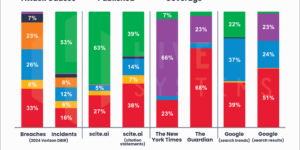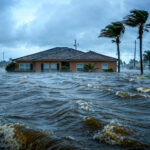
The Travelers Companies reported net income of $733 million for the first quarter of 2021, compared to $600 million in the prior year quarter.
Core income in the current quarter was $699 million compared to $676 million in the prior year quarter. Core income increased primarily due to higher net favorable prior year reserve development, a higher underlying underwriting gain and higher net investment income, partially offset by higher catastrophe losses.
“The strength of our underwriting and investment expertise enabled us to deliver strong profitability, notwithstanding the severe winter weather. As a result, we are off to a terrific start to the year,” Alan Schnitzer, chairman and chief executive officer, said.
The combined ratio of 96.6% increased 1.1 points due to higher catastrophe losses (6.7 points), partially offset by higher net favorable prior year reserve development (3.8 points) and a lower underlying combined ratio (1.8 points). The underlying combined ratio of 89.5% improved 1.8 points.
Schnitzer said underlying underwriting income was “meaningfully higher” than in the prior year quarter, driven by higher net earned premiums and an underlying combined ratio which improved to 89.5%.
Catastrophe losses of $835 million pre-tax compared to $333 million pre-tax in the prior year quarter.m Catastrophe losses primarily resulted from winter storms and wind storms in several regions of the United States.
Net realized investment gains in the current quarter were $44 million pre-tax ($34 million after-tax), compared to net realized investment losses of $98 million pre-tax ($76 million after-tax) in the prior year quarter.
The insurer returned $613 million of excess capital to its shareholders in the quarter, including $397 million of share repurchases.
Business Insurance
Income for Business Insurance was $317 million after-tax, an increase of $28 million that is attributable to a higher underlying underwriting gain, higher net favorable prior year reserve development and higher net investment income, partially offset by higher catastrophe losses.
The combined ratio for Business Insurance of 103.5% was an increase of 1.3 points due to higher catastrophe losses (8.3 points), partially offset by a lower underlying combined ratio (3.6 points) and higher net favorable prior year reserve development (3.4 points).
The underlying combined ratio of 93.7% improved by 3.6 points, primarily reflecting earned pricing that exceeded loss cost trends, as well as a net charge related to COVID-19 and related economic conditions in the prior year quarter.
Business Insurance net written premiums of $4.125 billion decreased 2% in part due to lower net written premiums in the workers’ compensation product line due to the impact of COVID-19 and related economic conditions on payrolls.
Bond & Specialty Insurance
Income for Bond & Specialty Insurance was $137 million after-tax, an increase of $15 million. Segment income increased primarily due to a higher underlying underwriting gain and net favorable prior year reserve development, partially offset by higher catastrophe losses. The underlying underwriting gain benefited from higher business volumes.
The combined ratio of 85.2% improved 0.7 points due to higher net favorable prior year reserve development (2.1 points) and a lower underlying combined ratio (1.5 points), partially offset by higher catastrophe losses (2.9 points).
The underlying combined ratio of 84.2% improved 1.5 points, primarily reflecting earned pricing that exceeded loss cost trends and a lower expense ratio resulting primarily from higher premium volumes, partially offset by other loss activity, including the impact of COVID-19 and related economic conditions.
Net favorable prior year reserve development was driven by better than expected loss experience in the surety product line for multiple accident years.
Net written premiums of $723 million increased 9%, reflecting continued strong retention and increased levels of renewal premium change in management liability.
Personal Insurance
Income for Personal Insurance was $314 million after-tax, a decrease of $22 million. The income decreased primarily due to higher catastrophe losses and a lower underlying underwriting gain, partially offset by higher net favorable prior year reserve development and higher net investment income. The underlying underwriting gain benefited from higher business volumes.
The combined ratio of 90.3% increased 2.1 points due to higher catastrophe losses (5.8 points) and a higher underlying combined ratio (1.4 points), partially offset by higher net favorable prior year reserve development (5.1 points).
The underlying combined ratio of 85.4% increased 1.4 points, driven by higher losses in the homeowners and other product line primarily attributable to a comparison to a low level of non-catastrophe weather-related losses in the prior year quarter, partially offset by lower losses in the automobile product line due to a decrease in miles driven primarily attributable to COVID-19 and related economic conditions.
Net favorable prior year reserve development was driven by better than expected loss experience in domestic operations in both the homeowners and other and automobile product lines for recent accident years. Included in net favorable prior year reserve development was a subrogation benefit of $62 million from Southern California Edison Company related to the 2018 Woolsey wildfire in California.
Net written Personal Insurance premiums of $2.657 billion increased 7%. Domestic automobile net written premiums increased 3%, driven by strong retention and higher levels of new business. Domestic homeowners and other net written premiums increased 12%, driven by strong retention, renewal premium change of 8% and higher levels of new business.
Source: Travelers
*This story ran previously in our sister publication Insurance Journal.



















 Dear Elon and Vivek: Insurance Commissioners Urge DOGE to Ditch FIO
Dear Elon and Vivek: Insurance Commissioners Urge DOGE to Ditch FIO  Study: Widening Gap Between Cyber Attack Causes, Public Perception
Study: Widening Gap Between Cyber Attack Causes, Public Perception  Slideshow: Carrier Management’s 2024 Top Editor’s Picks (Unlocked)
Slideshow: Carrier Management’s 2024 Top Editor’s Picks (Unlocked)  National Flood Insurance Program Authorized to Continue Through Mid-March
National Flood Insurance Program Authorized to Continue Through Mid-March 


